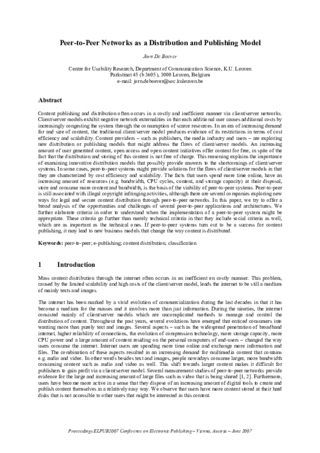Content publishing and distribution often occurs in a costly and inefficient manner via client/server networks. Client/server models exhibit negative network externalities in that each additional user causes additional costs by increasingly congesting the system through the consumption of scarce resources. In an era of increasing demand for and size of content, the traditional client/server model produces evidence of its restrictions in terms of cost efficiency and scalability. Content providers - such as publishers, the media industry and users - are exploring new distribution or publishing models that might address the flaws of client/server models. An increasing amount of user generated content, open access and open content initiatives offer content for free, in spite of the fact that the distribution and storing of this content is not free of charge. This reasoning explains the importance of examining innovative distribution models that possibly provide answers to the shortcomings of client/server systems. In some cases, peer-to-peer systems might provide solutions for the flaws of client/server models in that they are characterized by cost efficiency and scalability. The facts that users spend more time online, have an increasing amount of resources (e.g. bandwidth, CPU cycles, content, and storage capacity) at their disposal, store and consume more content and bandwidth, is the basis of the viability of peer-to-peer systems. Peer-to-peer is still associated with illegal copyright infringing activities, although there are several companies exploring new ways for legal and secure content distribution through peer-to-peer networks. In this paper, we try to offer a broad analysis of the opportunities and challenges of several peer-to-peer applications and architectures. We further elaborate criteria in order to understand when the implementation of a peer-to-peer system might be appropriate. These criteria go further than merely technical criteria in that they include social criteria as well, which are as important as the technical ones. If peer-to-peer systems turn out to be a success for content publishing, it may lead to new business models that change the way content is distributed.
De Boever, Jorn. "Peer-to-Peer Networks as a Distribution and Publishing Model." In Openness in Digital Publishing: Awareness, Discovery and Access - Proceedings of the 11th International Conference on Electronic Publishing, 175-188. ELPUB. Vienna, Austria, 2007.
